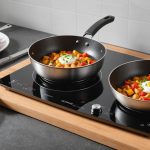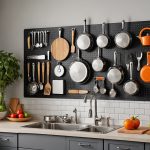Importance of a Kitchen Herb Garden
A kitchen herb garden offers multiple benefits that go beyond merely enhancing the flavour of your meals. One significant advantage is the fresh, vibrant taste fresh herbs add to dishes. When you incorporate home-grown herbs into your cooking, you’ll notice a remarkable difference compared to using dried alternatives.
The health benefits of a kitchen herb garden should not be overlooked. Herbs like basil and parsley are packed with antioxidants, vitamins, and minerals that contribute positively to your diet. Growing them indoors ensures you have a steady supply of these beneficial herbs without any additives or pesticides.
Also read : Unlock culinary precision: the ultimate guide to selecting the ideal kitchen timer in the uk
Another noteworthy aspect is the eco-friendly benefits of maintaining a kitchen herb garden. Growing your own herbs reduces the demand for commercially packaged products, which often involve environmentally taxing processes such as transportation and packaging. Besides, having a garden at your fingertips minimises waste, as you can harvest only what you need.
Indoor gardening can be a soothing hobby, providing a sense of accomplishment as you watch your plants grow. A herb garden not only serves practical purposes but also enhances the indoor environment, adding a touch of greenery to your space.
In parallel : Ultimate guide to maintaining oak worktops in your uk kitchen: must-know tips for longevity and care
Selecting the Right Herbs for Your Kitchen Window
Finding the best herbs for indoors can be a delightful journey, transforming any window into a lush, aromatic corner of your home. The right herb selection can ensure successful growth and provide a healthy addition to your cooking.
Popular Herbs for UK Kitchen Windows
In the UK, several herbs thrive particularly well indoors. Basil, parsley, and mint are popular choices due to their versatility and ease of growth. These herbs flourish when placed in well-lit positions, enabling them to receive adequate sunlight. Plus, they can be used in various recipes, bringing fresh flavours to your meals daily.
Considerations for Herb Selection
Before diving into growing herbs indoors, consider your kitchen’s lighting and space. Some herbs require more sunlight, while others are less demanding. Choosing pots with drainage holes and selecting herbs that match the light levels in your home is critical. Additionally, ensure you have enough space for them to grow comfortably without feeling cramped.
Understanding Herb Growth Requirements
Understanding the specific growth requirements of each herb is essential. Basil, for instance, loves warmth and sun, while mint prefers cooler temperatures and indirect light. By aligning conditions with each herb’s needs, you’ll create a thriving environment that encourages robust growth and continued bounty.
Preparing Your Kitchen Window for Planting
Before beginning your indoor planting journey, proper window preparation can significantly impact success. The first step is assessing sunlight exposure. Most herbs thrive with ample sunlight, so choose windows that receive a minimum of four to six hours of direct sunlight daily. South or west-facing windows provide optimal conditions. If such windows aren’t available, consider supplemental lighting options like grow lights to enhance growth.
Another critical consideration is selecting the right containers. Ensure they have sufficient drainage holes to prevent waterlogging, which can be detrimental to any herb garden setup. Opt for small to medium-sized pots that accommodate growth but don’t overwhelm your space. Materials such as terracotta or ceramic can maintain soil moisture effectively, adding to both functionality and aesthetic appeal.
Space optimization is vital when arranging your window setup. Vertical stands or tiered shelves increase accessibility and prevent clutter, allowing each plant to access required sunlight. Finally, utilise quality potting soil for herbs—it’s often lighter, retains moisture well, and provides abundant nutrients. Including a layer of gravel or sand at the bottom of pots can improve drainage, supporting healthier root development.
Step-by-Step Planting Process
Embarking on your herb garden setup can be an enjoyable and rewarding endeavour. Proper planting techniques ensure robust growth and a flourishing array of herbs.
Gather Necessary Tools and Materials
Start by assembling the essentials for your herb garden. You’ll need planting containers with drainage holes, quality potting soil, a small trowel, and a watering can. Additionally, if sowing seeds, prepare small markers to label each herb. Having these tools within reach will streamline your planting process and enhance indoor gardening efficiency.
Sowing Seeds or Planting Seedlings
Decide whether to sow seeds or plant young seedlings. For seeds, follow the instructions on the packet regarding soil depth and spacing. If planting seedlings, dig small holes in the soil, place the herbs, and gently firm the soil around the roots. Properly positioning the plants is crucial to ensure they can grow vigorously within your home’s environment.
Watering and Initial Care
Once your herbs are in place, initiate careful watering techniques. Water enough to moisten the soil without over-saturating it, preventing root rot. Position the pots in well-chosen locations, optimising the light and space they receive, fostering a thriving start for your indoor herb garden.
Maintaining Your Herb Garden
Maintaining your herb garden ensures continuous growth and the freshest supply of herbs for your kitchen. Regular herb care involves setting a consistent watering schedule. Most herbs prefer the soil to be moist but not waterlogged; overwatering can lead to root rot. Monitor the soil to adjust the frequency of watering based on your plant’s needs and the season.
Feeding your indoor plants is essential for robust health. Utilize a balanced, water-soluble fertilizer monthly. This provides the nutrients required to sustain herb vitality and encourage new growth.
Pruning is a crucial part of maintenance tips. Trim your herbs regularly to promote bushy growth and prevent them from becoming leggy. This enhances flavour concentration and boosts leaf production. When harvesting, always cut just above a leaf node to stimulate new growth.
It’s also important to consider pest control and disease management. Inspect plants regularly for signs of pests like aphids or spider mites. Organic solutions, such as neem oil, can effectively manage infestations without harming your herbs. Keeping leaves dry and maintaining adequate ventilation helps reduce fungal diseases, ensuring your herb garden thrives healthily indoors.
Troubleshooting Common Challenges
Establishing a thriving kitchen herb garden indoors can occasionally lead to challenges. Understanding these issues equips you with the tools needed to overcome them.
Addressing Poor Growth
When herbs exhibit slow or stunted growth, several factors might be responsible. Insufficient sunlight is a common culprit. Ensure your herbs are positioned to receive ample light, or consider supplemental grow lights in areas lacking natural sunlight. Soil quality is another potential issue; using enriched potting soil helps provide essential nutrients. Check for root crowding; if roots outgrow their containers, repotting with fresh soil can promote healthier development.
Solutions for Pests
Indoor gardens aren’t immune to pests. Aphids and spider mites frequently infest indoor herbs. Regularly inspect your plants, paying close attention to the undersides of leaves. For infestations, use neem oil or a homemade soap spray to deter pests without harming the plants.
Managing Environmental Factors
Fluctuating temperatures and humidity can stress herbs. Keep plants away from heat sources or cold drafts, and maintain a consistent indoor climate. A gentle misting can increase humidity levels, particularly in dry environments, benefiting most herbs. By focusing on creating stable conditions, you’ll foster a robust and flourishing herb garden.
Maximizing Space and Aesthetics
When it comes to creating an inviting herb garden indoors, imaginative ideas can transform limited areas while ensuring functional beauty. Consider implementing vertical gardens or utilising wall-mounted planters. These solutions optimise small spaces by elevating plants, letting your kitchen herb garden flourish without crowding countertops.
Incorporating herbs into your kitchen décor not only brings the outdoors in but also infuses your space with a natural vibe. Use containers that complement your interior style, whether rustic ceramic pots, sleek modern planters, or classic mason jars, to seamlessly blend with your existing design.
Arranging herbs for optimal growth and accessibility is key. Position taller herbs, like basil, at the back and shorter ones, such as thyme, in front. Ensure each plant gets ample sunlight by arranging them in tiers if space permits. Next, consider arranging herbs near the kitchen workspace for convenience, allowing for easy access when cooking.
Personalising your herb garden enhances its functionality and aesthetics, making it a cherished element of your home. Utilising creative solutions for space optimisation helps maintain a thriving garden and adds a charming touch to your kitchen environment.
Resources and Further Reading
Accessing comprehensive gardening resources can significantly enhance your indoor herb gardening experience. Diving into online forums and communities connects you with fellow enthusiasts who share advice and troubleshoot issues. These platforms offer real-time feedback and innovative ideas from seasoned herb gardeners, making them invaluable tools for continual learning.
Exploring recommended books on gardening provides in-depth knowledge. Titles focusing on indoor herb cultivation tend to feature specific guidance on plant care, highlighting best practices that are particularly beneficial for those new to this hobby. These books often include detailed images and step-by-step instructions, aiding comprehension and practical application.
Enhancing your skills through local gardening workshops and events is another excellent option. Many communities offer sessions led by experts, covering topics from basic plant care to advanced indoor gardening techniques. These workshops not only refine your skills but also offer networking opportunities to connect with like-minded individuals.
To elevate your knowledge further, explore a combination of these resources. Whether immersing in a book, joining a forum, or attending a workshop, numerous avenues exist to expand your understanding and enhance the success of your kitchen herb garden.











